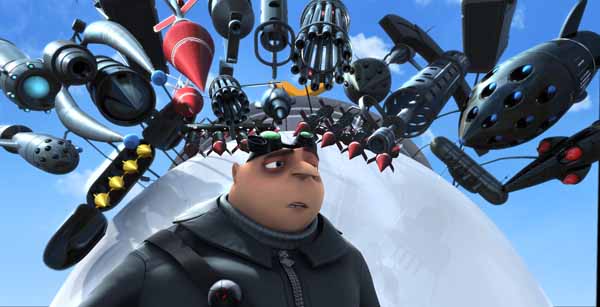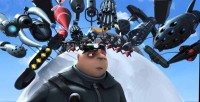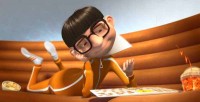 CG animation has completely revolutionised the film industry. In almost every blockbuster film released these days there’s an element of CG, whether the film be completely animated or a live action adventure. We recently got the chance to interview one of the producers of Despicable Me, Janet Healy, who has a long standing history of working on films that changed the way CG was used in the movie making process. It’s a fascinating look into how far we’ve come in such a short period of time…
CG animation has completely revolutionised the film industry. In almost every blockbuster film released these days there’s an element of CG, whether the film be completely animated or a live action adventure. We recently got the chance to interview one of the producers of Despicable Me, Janet Healy, who has a long standing history of working on films that changed the way CG was used in the movie making process. It’s a fascinating look into how far we’ve come in such a short period of time…
Giz: We should start by pointing out you’ve worked Visual Effects on some of the all-time greatest effects movies. Terminator 2 and Jurassic Park in particular. How long ago did you see the ‘digital revolution’ as something that was absolutely going to change movies forever?
Janet Healy: During Terminator 2 we started to understand that with some smart engineering, plenty of time and the kind of vision that Jim Cameron provides, almost anything was possible for CG filmmaking. It was during Jurassic park that all the innovation became easier – we could move the cameras, bring organic creatures to life in close ups, plus keep all the elements within the digital sphere so they married more easily with the background plates. By the time we finished Jurassic park, we all knew that how we previously made movies had changed very quickly. It was an exciting realisation!
Giz: You’ve been there to blend CG and reality, and now with Despicable Me you’re into a pure CG world. How does the process change when you leave actual footage out of the equation?
JH: One of the things i love about all CG animation is the amount of flexibility and control we have. We can change any part of the image at any time and this maleability is creatively empowering. We are not bound to real world imagery since there is not the issue of matching plate elements with CG. So the amount of stylisation is not constrained; in CG we can make incredible fantasy worlds and explore imagery that has never been seen before. It’s a lot easier to manage because all CG doesn’t require a plate shoot, match moving cameras, articulated roto mattes and colour matching of CG elements to plate elements.
 Giz: How has CG been streamlined as an art?
Giz: How has CG been streamlined as an art?
JH: For me there was a big change between Jurassic park and Casper, and that had to do with scalability, the amount of CG work that could be reliably done in any given time. Since then the costs of processors and space has decreased hugely, accessible high end CG tools have become affordable and prevalent, and the experienced work force worldwide has grown in great magnitude. Now many artists know how to do amazing work and I find I get to concentrate more on the art, the story, the animation and the look rather than building a pipeline and new technological foundations for every film.
Giz: And where has it become more complex in order to handle the increasing demands?
JH: I have found that every film becomes visually more complex than the last film. We push the quality of character animation and effects, the number of sets and props plus the amount of things we see in frame at any given moment. 3D stereo has made it even more of a challenge to get everything rendered well for two eyes instead of just one. But the results on screen are always worth it to me.
Giz: If you could make life easier by blending the best of ‘traditional’ and CG filmmaking, which parts of each would you want to keep?
JH: I think it’s important that we keep the filmic language that we, as audience members take for granted from our long histories of watching films. What makes a great story and a compelling character? How do we use light, colour and camera mechanics to enhance or change the mood and best suit that story? What is it about the acting performances that move us and draw us into the narrative? These are the challenges of all fictional filmmaking, no matter the medium. Computers and digital cameras are changing our cinematic language so it is certainly an exciting time for movies.
Giz: Is CG production today more like cel animation, or more like actual cinematography? Or somewhere between?
JH: The artistic steps of working in CG virtual sets with virtual cameras and virtual characters are very similar to live action filmmaking. I personally find CG is closer to live action than to hand drawn animation; the latter takes many steps and often a good deal time before one can see an image come together. I love the surprise and the amount of invention that regularly happens in CG, and appreciate how we as an industry push the envelope over and over again to create unique, incredibly visual, entertaining stories.
 Giz: While we leave ‘reality’ out more and more, are characters still largely based on motion capture and actor facial expressions? How do you keep the humanity in the characters?
Giz: While we leave ‘reality’ out more and more, are characters still largely based on motion capture and actor facial expressions? How do you keep the humanity in the characters?
JH: Animation is unique because of the opportunity to explore exaggeration. I think the humanity comes a good deal from the voice performances and the animators’ talents. A well designed character and good material help a lot too. It is the wondrous performing talent of these artists that can bring inanimate objects to life. I see animators every day make surprising and inventive performance choices without motion capture and reference footage, just from their instincts as performers. It is a fantastic process to behold and it is at the essence of why i love animation.
Giz: How are frames rendered these days? Are the studios managing their own server farms, or are off-site rendering options used?
JH: I am not sure how others are handling their rendering needs – for Despicable Me, we maintained our own render farm on site.
Giz: How long did frames and scenes take to render back in the T2 and Jurassic Park days? How much faster is the process now, or have filmmakers just added more complexity so it still takes just as long?
JH: I don’t know the specifics but I do remember a few decades ago that we would carefully divide up the available processors every night to see how much we could get rendered by next morning. We would render shots every tenth frame and turn off motion blur and it was always a struggle for people to see their work in a timely fashion. Now we are almost real time rendering in many departments and the feedback to the artists is immediate. It does mean that the quality has increased along with the number of iterations an artist can do. And complexity will always rise to fill every available CG resource I have found.
Giz: What do you love most about working in visual effects in the 21st century?
JH: I love movies in general and I love working in CG feature animation specifically. The global talent pool is incredibly skilled now and their tools are more robust and intuitive every year. I get to bring dozens and dozens of artists from many different disciplines together to make wonderful images and it is usually a surprisingly organized, predictable and controllable way to make films. Even things like hair, fur and water are achievable and look good these days. I think we can do anything we can imagine for the big screen and it is a pleasure to get to work every day with such talented, smart people.
Giz: Will we ever render perfect CG humans? Or will our eye always know we’re not watching a real person?
JH: I think that realistic humans would be achievable and that several filmmakers have done a great job already. Since I tend to work on all CG films, the challenges of photorealism are not generally within my arena. I am more interested to find very stylised and appealing characters that are different from characters we see within the real world.
Giz: What achievement in visual effects has yet to happen but that you want to see?
JH: I would love to be able to sit in the middle of a holographic film, with the characters and environments all around me, just as though I were there in the midst of their time and place. I would love to be in Gru’s lab with Gru, the girls and the minions to watch them all perform like in a virtual movie in the round. That all sounds great to me but very hard to produce!